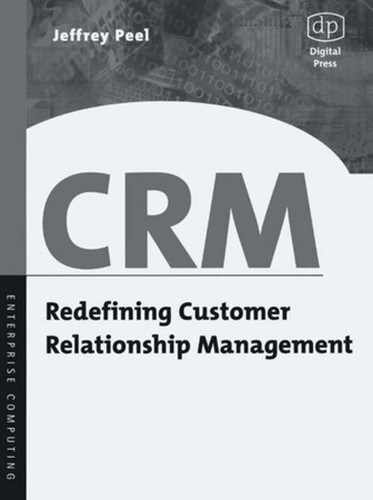
148 9.9 A strategy for channel development
9.9
"Analytical scenarios" will need to be defined before a CRM system is
built. Standard interaction system "events" will be defined to ensure that sys-
tem administrators are not required to make up their own analysis runs on the
fly or be required to anticipate all analysis scenarios. For example, if the ven-
dor is to initiate contact with a specified customer segment, the system must
have sufficient process logic to be able to alert the system operator to the fact
that certain customers in the selected subgroup have not responded to previ-
ous "campaigns." It should also cross-check automatically with suppression
lists~for example, lists of customers who have dubious payment histories or
are in dispute. Much of this is common practice in organizations that engage
in direct marketing, but the processes for CRM need to be more tightly
defined and more intricate and must be constantly updated in the light of
ongoing customer engagement.
Too often, the role ofanalytics in a CRM implementation is insufficiently
defined. CRM tools may be used to develop campaigns or to mine databases
on the basis of specified parameters. Analytics have a key role to play in ensur-
ing that poor performance is identified. Analytical CRM needs to perform a
monitoring and control function.
Monitoring and control in this context means that analytics need to run
constantly~checking for aberrations in the database, running deduping rou-
tines, highlighting data gaps, and alerting for inactive or sleeping customers.
Analytical tools have myriad tasks to perform. They can be used to generate
daily "birthday" runs, highlight change of address details, and perform similar
actions. In addition, they can be primed to perform quality performance
measures and act almost as an expert system, ensuring that customer data are
constantly being reassessed.
A strategy for channel development
No other issue causes more debate in CRM circles than the issue of integrating
voice and textual data. Many vendors of call-center applications claim that
they have developed systems that have unified queues; as a result, contact-
center agents may be dealing with a customer in a chat session one minute and
in a voice session the next.
While many vendors talk about unified applications handling both voice
and electronic channels, the actuality in terms of agent interface is very differ-
ent. Blending channels requires a mix of skills in the agents that many of them
will not possess. At a technological level, the applications are unlikely to be
genuinely blended; there may be some commonality in look and feel of appli-

9.9 A strategy for channel development 149
cation, but to all intents and purposes e-channel management applications
and voice channel are entirely separated.
From a process point of view what constitutes best practice and what
technology will emerge?
The first point that needs to be made is that regardless of the systems that
are developed to support contact-center staff, agents who can use a multiplic-
ity of communications channels will be much more enabled than the typical
agent in many call-centers today. The true multichannel agent will be re-
quired to adapt constantly to media and customers requiring different types of
interaction. The systems that will emerge to support such staff will, in effect,
be highly developed "expert systems."
In my view, processes will be more easily established and managed if cer-
tain channels "win the day." What do I mean? Currently, there is a widely held
view that two very different channels can in some miraculous way be unified
or merged (e.g., traditional telephone and Internet protocol [IP]-based mes-
saging). In my view, IP messaging will become dominant. And my logic is
based on an observation.
Customers who currently have a preference for engaging using traditional
telephone tend to be channel loyal. Customers who use electronic channels
tend to be channel disloyal. However, the tendency for e-channel fans to use
the phone is largely driven by the current inadequacy of the e-channel. And it
is at this point that I'd make a very outrageous comment and one that at first
sight may appear to run contrary to my previous arguments about consistency
of customer experience across channels.
In my view, as e-channel becomes more robust, the requirement for
customers to engage by the traditional telephone channel will diminish. Cus-
tomers using the telephone will tend to strongly favor that channel. At a
certain point it may become practical to make the use of the telephone less
practical for e-channel customers. In other words, create two customer cen-
ters: one for telephone customers and one for e-channel (embracing VolP).
There's a weird logic in this approach. The development of an all-IP con-
tact center will support a customer base that will grow markedly over time.
The development of systems and processes to support such customers will be
relatively simple. For example, IP-based contact systems can support voice
mail interaction, e-mails, Web forms, and synchronous voice and chat. Facili-
ties for categorizing and routing contact can be made consistent, and contact-
center user interfaces can be made highly flexible using a portal-based
application environment.
I Chapter 9
..................Content has been hidden....................
You can't read the all page of ebook, please click here login for view all page.
